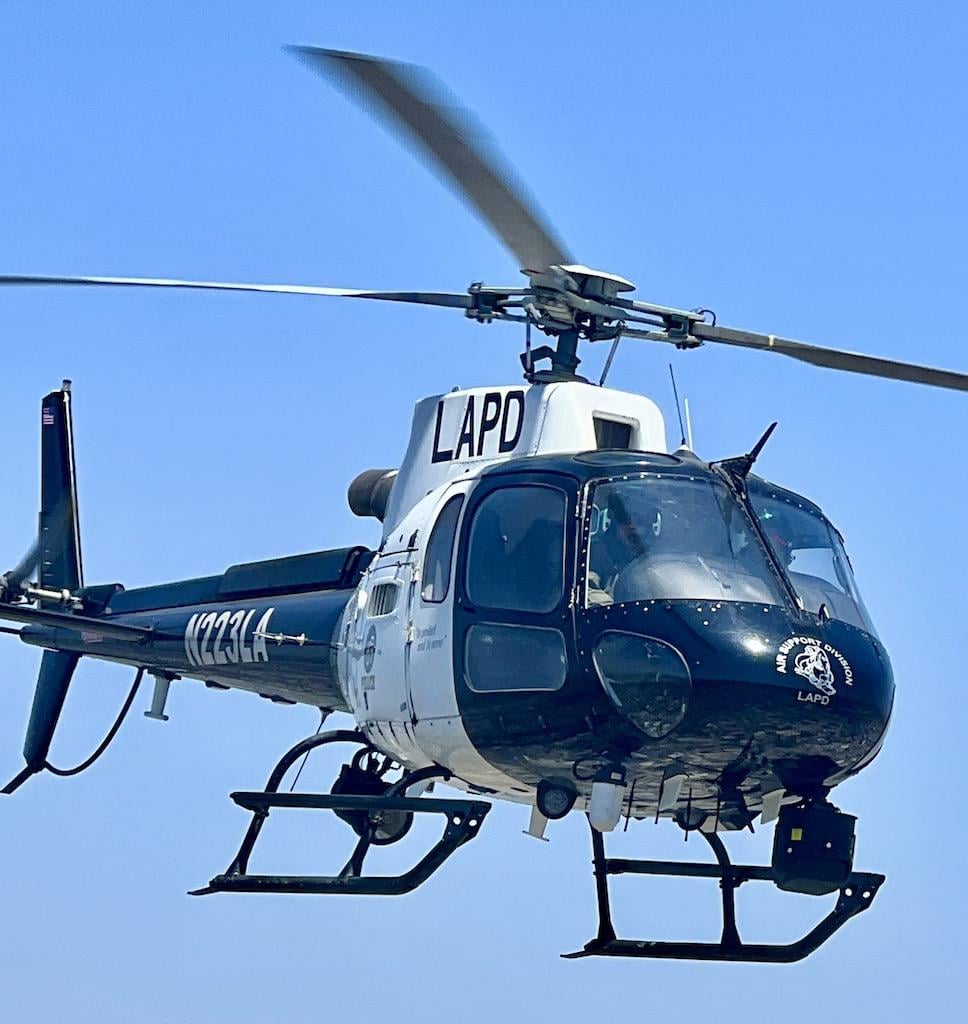Virtual Reality Simulator Provides Realistic Training Scenarios, Part 2

LAPD helicopters are equipped with forward looking infrared sensors, a camera system, a spot light and a data link system capable of streaming video to command and control centers.
The ability of full-motion flight simulators to mimic an IFR approach to a snowy runway has been the undisputed “best industry practice” for several decades. While these flight simulators meet the needs of other aviation operators who are primarily flying from Point A to Point B in the IFR environment, they do not have the visual capability to accurately simulate challenging flight conditions in a realistic 3D view, especially over the urban landscape from the perspective of a law enforcement helicopter.
For years the Los Angeles Police Department (LAPD) Air Support Division sent its pilots to simulator training centers to accomplish abnormal, emergency and IFR procedure training, but this involved considerable cost and man-hour loss due to travel, not to mention the inherent limitations of the sophisticated simulators to replicate the law enforcement environment. Furthermore, the simulators were unable to integrate tactical flight officers (TFO) into the scenarios.
“It’s incredibly challenging for any pilot today to realistically train for the dangerous maneuvers and diverse scenarios in which we fly,” says Kevin Gallagher, chief pilot of the LAPD Air Support Division. “Learning and mastering the skills and procedures needed to fly under instrument flight rules and to survive an inadvertent flight into IMC is no exception.”
Gallagher added: “Other aviation organizations have similarly seen that the more frequent the training and the closer it is adapted to pilots’ mission needs, the higher the skill level in daily flight operations.”
The tragic accident at Huntington Beach in California, described earlier, reinforces this point, as training records indicated that the last time the pilot had received unanticipated right yaw training specific to the accident helicopter type was about seven years before the accident.
It is a considerable challenge for a flight organization, especially one operating under the tight budget pressures faced by city governments, to provide the realistic and frequent training needed to maintain sharp flying skills. While full-motion flight simulators fulfilled some of this need, there had to be a better alternative.
An answer to this void came from the team at Loft Dynamics (formerly VRM Switzerland), which has focused on the development and certification of an Airbus H125 Level 3 Flight Simulation Training Device (FSTD) utilizing virtual reality technology.
Since BCA’s site visit in May 2022 to experience the technology first hand at the company’s facility in Zürich (“Flying the VRM Airbus H125 Simulator,” Sept. 6, 2022), a number of aviation operators have started using the technology for recurrent training requirements. Helitrans, Norway’s largest domestic helicopter operator, became the first company to operate a qualified Virtual Reality (VR) Level 3 FSTD.
The newly certified technology allows an operator to train for high-risk scenarios without endangering an actual aircraft and crew. Secondly, it is cost and time efficient at providing training and checks. Third, it provides realism, size, and affordability at a fraction of the cost of a traditional simulator. Additionally, an operator isn’t putting expensive cycles on a helicopter engine or flight hours on time-limited parts, nor worrying about the fuel budget.
LAPD Plans Simulator Purchase
On Feb. 1, 2024, the LAPD initiated the process to purchase an H125 VR Sim from Loft Dynamics. While the process within the auspices of a city government is a complex entanglement of politics and bureaucratic rules, if/when the purchase is authorized, the FSTD will be installed in the hangar at the LAPD’s Hooper Memorial heliport in downtown Los Angeles. The immense rooftop heliport is 600-by-210 ft. and sits atop the C. Erwin Piper Technical Center, approximately one mile northeast of the central business district. The city owns the complex for use by the LAPD.
In order to provide the fullest realism possible for the department’s mission environment, the team of engineering specialists at Loft Dynamics who created the visual landscapes spent considerable man-hours precisely modeling many of the urban areas in the Los Angeles region. This will enable a trainee to land in these areas with an accurate replication of the exact heights and dimensions of streets, parking lots and buildings.
The realism will be especially pertinent in the practice of simulated forced landings, as well as the practice of a typical law enforcement mission involving crime scenes with multiple police cars. The Loft Dynamics team is also modeling the tops of actual buildings in the region, which will allow practice landings. The detailed modeling has far greater fidelity than simply importing scenery from Google Earth, and contributes to the realism of the visual scene.
“Loft Dynamics’ sims use cloud-based software, which will allow the LAPD to add new and applicable training scenarios regularly,” says Gallagher. “Additionally, the sim’s full-motion technology precisely replicates the motion of a helicopter in-flight, while the visual technology accurately simulates challenging flight conditions in a realistic 3D view.
"These features are critical to providing our 50-plus pilots, who fly around the clock, with the types of conditions and maneuvers they often encounter. With the sim onsite, our pilots can regularly and safely train to maintain proficiency in these essential skills.”
We describe the training benefits of the virtual reality simulator in Part 3 of this article.
Virtual Reality Simulator Provides Realistic Training Scenarios, Part 1: https://aviationweek.com/business-aviation/safety-ops-regulation/virtua…





